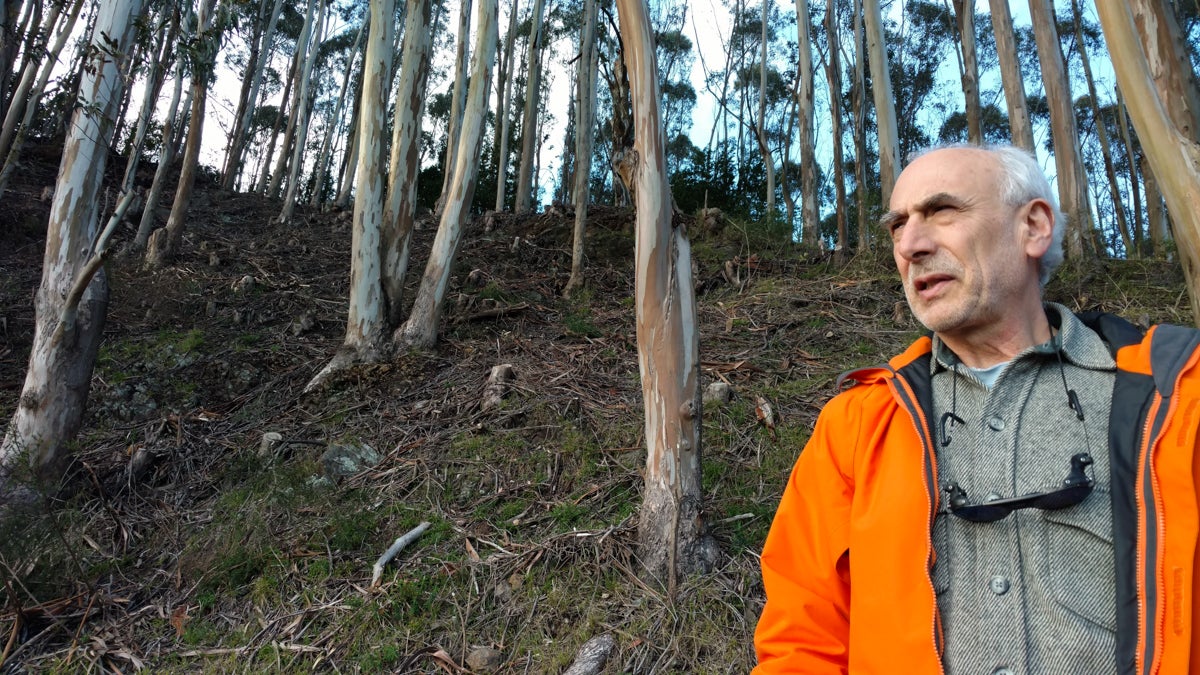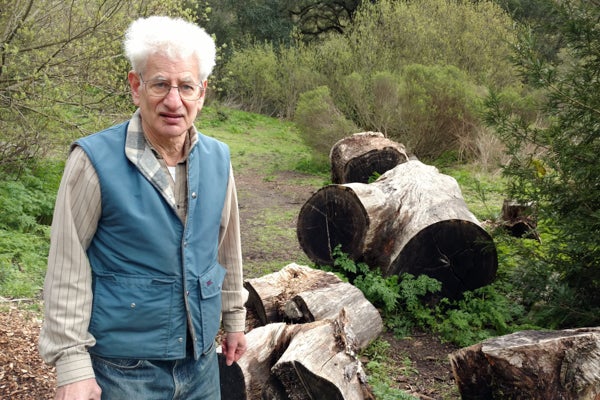Can the eucalyptus ever be accepted as a ‘native’ Californian?
Listen
Dan Grassetti with the Hills Conservation Network believes the tall eucalyptus trees in the Oakland Hills should remain. (Andrew Stelzer/for WHYY)
Two decades after the Oakland Hills firestorm, neighbors are still battling over the ‘flammable’ forest.
Walking along the trails near Claremont Canyon Road in Oakland, California, the air smells faintly minty–kind of like Vicks VapoRub. The eucalyptus trees–with their long, narrow, shiny leaves–can grow more than 100 feet high and create a beautiful shade canopy.
But, picturesque or not, Jon Kaufman wants the invasive eucalyptus trees gone.
“They’re a dirty tree in that sense in that they produce a lot of bark that falls off the tree and hangs down from the tree, and that creates a fire ladder,” Kaufman says.
“So when a fire starts on the ground for whatever reason, the fire can spread up to the top of the trees.”
Kaufman is Vice President of the Claremont Canyon Conservancy, a group of neighbors who try to keep homes safe by advocating for fire prevention policies.
All trees, brush, and vegetation are flammable, but Kaufman says blue-gum eucalyptus groves are especially fire-prone. Back in in the hot, dry October of 1991, these hills were the scene of the most devastating urban fire in California’s history.
25 people died, and more than 3,000 homes were destroyed in the Oakland Hills firestorm. Kaufman says eucalyptus trees helped aid the fire’s rapid spread.
“It was a horrendous fire,” he says. “My wife and I evacuated, and fortunately our house didn’t burn, but houses just above us on the hillside were almost totally consumed.”

Jon Kaufman with the Claremont Canyon Conservancy says removing the Eucalyptus trees will decrease the fire danger in the Oakland Hills. (Andrew Stelzer/for WHYY)
Fierce competitor
Eucalyptus trees are an Australian import from the mid-1800s, but they now dominate. Dead bark and the combustible oil in eucalyptus leaves make good tinder, but, ironically, the tree trunks are pretty resistant to fire. Trees in the eucalyptus family can be so hardy they are sometimes called ‘ironbark.’ And extreme heat actually helps the trees spread their seeds. There’s even a theory that the eucalyptus evolved to promote fire as a way to destroy other plants with whom they compete for resources.
In addition to the fire danger, the invasive eucalyptus dominates the local ecosystem in the hills of Oakland. The treetops block out the sun, and eucalyptus roots suck up lots of the water that competing native plants and trees need.
The Federal Emergency Management Agency (FEMA) agreed it would be wise to remove the eucalyptus. In 2015, the agency earmarked money to cull the forest. Even the tree-loving Sierra Club supported the plan to remove the trees.
Dan Grassetti says it was a bad plan.
“If there were ever a species that needed a public relations firm, it’s the eucalyptus,” said Grassetti, a member of a smaller group of hills residents that broke off to form their own pro-eucalyptus organization, called the Hills Conservation Network.
Walking through the forest, he marvels at the shade canopy and the feeling of isolation only 100 yards from the road.
“This is beautiful. This is amazing habitat. You get rid of essentially all the tall trees here, it would be a totally different environment,” Grassetti says.
Most scientists believe eucalyptus increase the fire danger, but Grassetti and his group point out that the plants that grew here before eucalyptus arrived often caught fire as well.
“The assertion that somehow the only species that is at play here is the eucalyptus, not the houses, not any of the other trees, it’s just specious logic,” he says.
The Hills Conservation Network sued FEMA, and after some legal wrangling, the new strategy is to remove far fewer trees than originally planned. The pro-eucalyptus faction won. But government experts still say eucalyptus is a fire risk, and opponents say fire science got lost in the fight.
Many fire management experts say nonnative eucalyptus just don’t belong in California at all.
For Tao Orion, author of “Beyond the War on Invasive Species,” it’s not that simple.
“Invasive species are often characterized as these kind of malevolent actors, and they’re not,” Orion says.
“They’re just plants or animals, and they have certain characteristics that fit the characteristics of the ecosystems where they’re found.”
Orion, who works as a land management consultant, says we shouldn’t automatically blame the plant; if a nonnative species is thriving, it shows that something in the environment is changing.
Orion’s backyard in Oregon has invasive blackberry plants. But rather than spraying pesticides on them, she usesd nature to control nature. She sicked her pigs on the blackberries.
“The pigs just went crazy. They loved the roots. They dug them all out…they ended up making it into an environment that Himalayan Blackberries don’t thrive as much.”
Fire management experts might argue she’s too lenient on the invaders, but Orion says you can’t just single out one nonnative plant as the enemy—and that includes the eucalyptus in the Oakland Hills.
“What I’ve come across in the conventional field of restoration is: ‘Well if we can just get rid of these plants and animals everything will just go back to normal and it will just be OK,'” Orion says.
“However, there’s a lot more to the story in terms of massive urban and suburban development, draining of wetlands, deforestation, all of these different things have led to the types of conditions that many invasive species favor.”
Humans brought eucalyptus to California, and we’ve done lots of other things to the landscape since. That could be a concern if there’s another big fire.
Bottom line: the edge of a flammable forest may just not be a very safe place for people to build houses. But Oakland’s real estate market is red hot, so, whether the eucalyptus go or not, the people and their homes aren’t leaving anytime soon.
WHYY is your source for fact-based, in-depth journalism and information. As a nonprofit organization, we rely on financial support from readers like you. Please give today.



